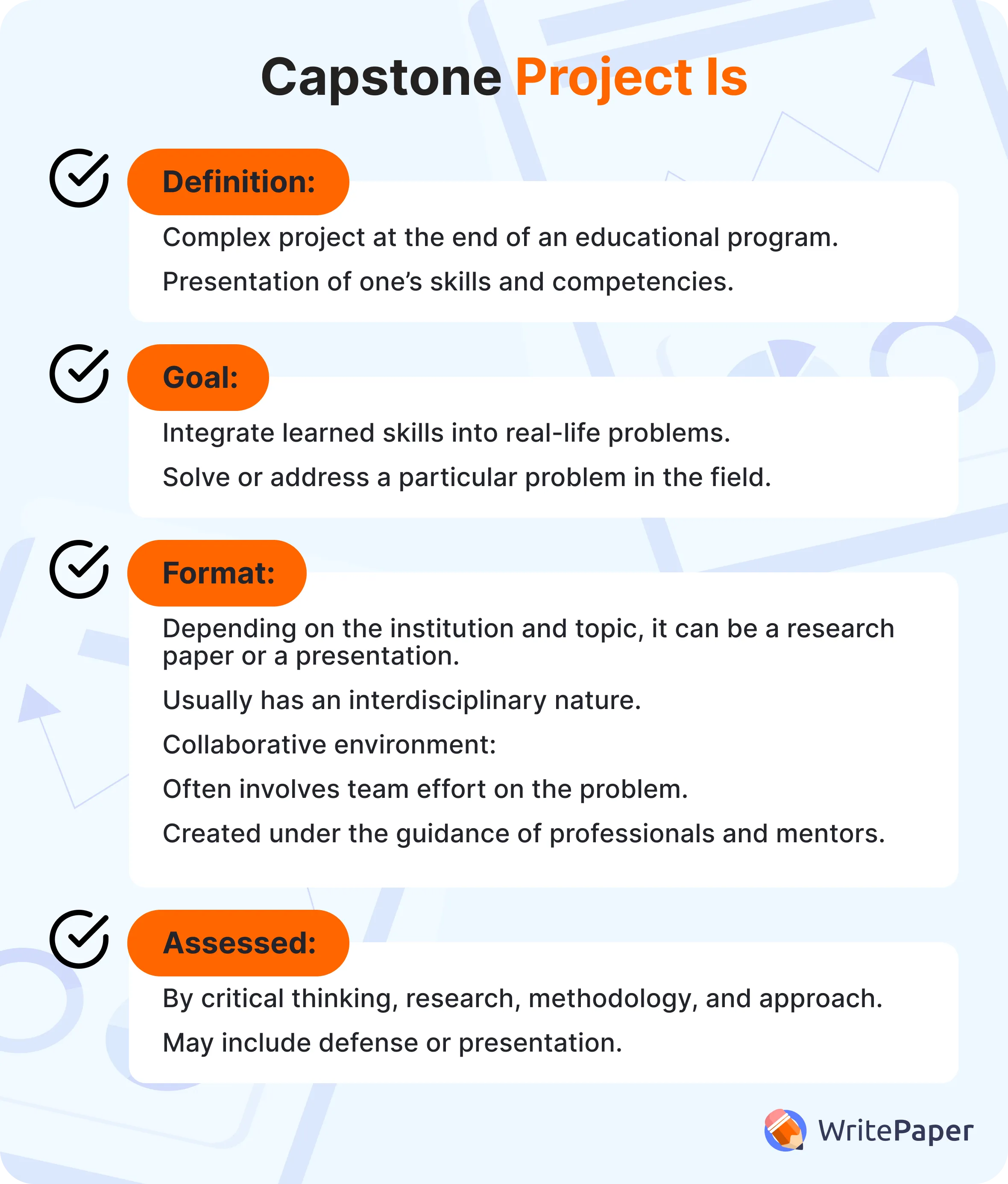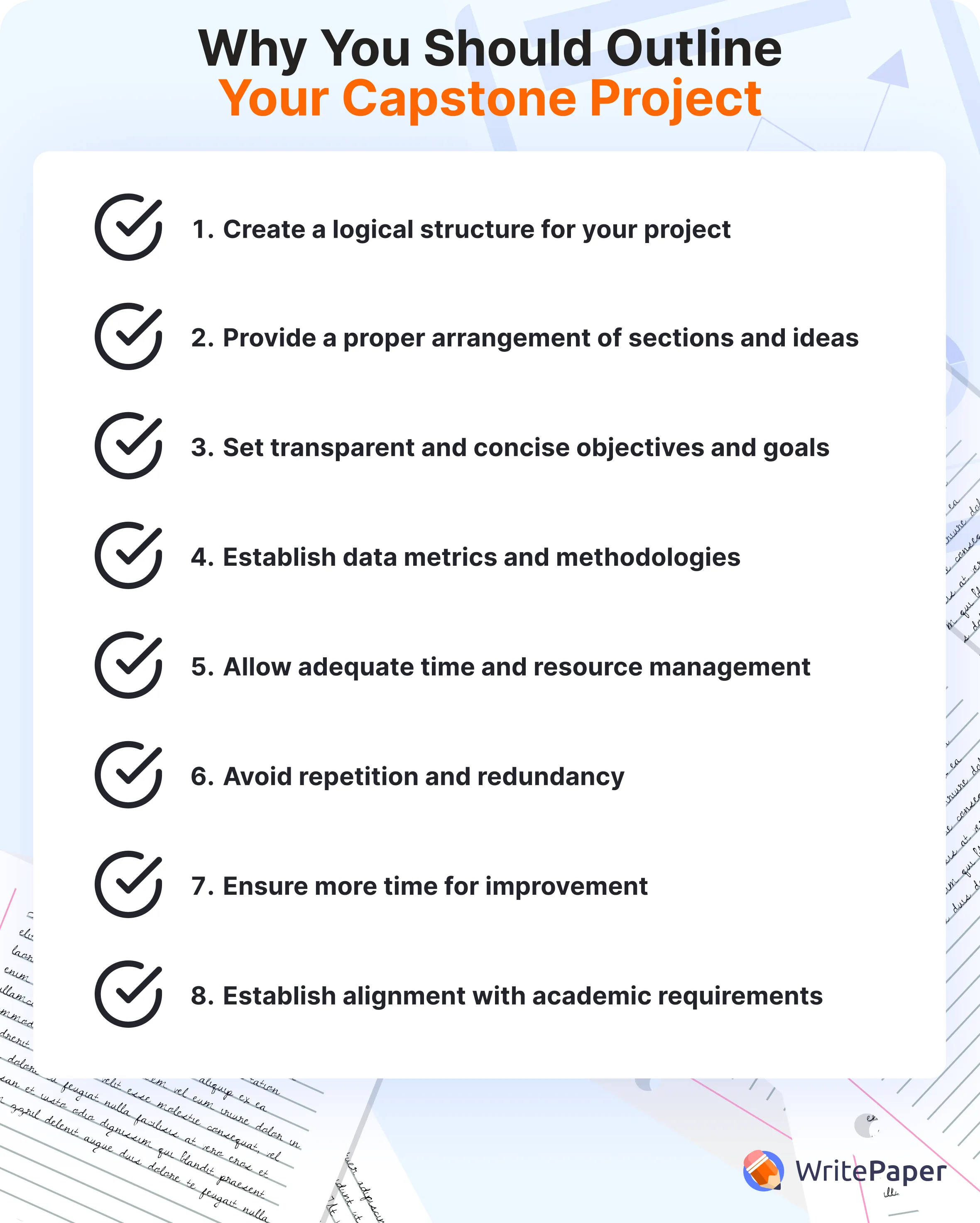A capstone project is a complex assignment that a learner usually does at the end of their educational journey. It requires a lot of knowledge, dedication, and effort. It is a common task that students must complete and present in their final year of studies. The goal is to showcase all the skills and competencies one has acquired through the program.
It is hard to underestimate the role of the capstone project outline in its overall success. It serves as a blueprint of the whole project and allows one to develop their findings logically. It becomes a guide in this journey, leading one’s research and writing. Without a proper blueprint, it is extremely difficult to create a logical and seamless flow of ideas and conclusions.
That’s why a capstone project outline is so crucial and needs focused attention. It makes it much easier to follow all of the requirements correctly. Also, it makes the whole capstone project structured and detailed. Putting it simply, without a roadmap, the journey would be chaotic and long. But with a proper plan, you know where you need to go and how to achieve it.
If you are at the beginning of your project, this guide will help you create a strong outline to guide you to a successful finish.

What Makes a Capstone Project Outline Crucial?
An outline for a capstone project is as important as a blueprint for building a house. It is impossible to build a reliable and well-designed house without a concise blueprint. The same goes for a scholarly work of such a scale. It needs a roadmap of what you want to achieve and how you are going to do it. Otherwise, the work on your capstone project can be chaotic, tedious, and ineffective.
The outline serves many purposes. It gives you a structure to organize capstone project ideas and tools correctly. It highlights the essential parts of the work as well. Additionally, it helps to correctly present all of the parts from a hypothesis to recommendations.
Creating a proper outline makes the whole Capstone Project more feasible, as you’ll see exactly what you need to do and in what order. Also, you might uncover some gaps in the knowledge of the topic. It is better to find out about them in the preliminary stage than during the defense. While working on it, you can find any gaps in your knowledge and resolve them.
Another huge part of it is the potential collaboration. With an outline, you can effectively communicate with mentors and peers who are involved in the project. It gives essential reference points and eliminates miscommunications.
Outline is crucial because:
- It gives a clear roadmap of the scope of work.
- Makes ideas and approaches structured.
- Helps to plan every stage.
- Allows for managing time correctly.
- Ensures everything is aligned with requirements.
- Promotes valuable research and focused effort.

How to Choose a Citation Style for Your Outline for Capstone Project
Overall, there are only three options when it comes to capstone project outline and formatting: APA, MLA, and Chicago. There might be rare cases of other styles, but the guide will focus on these most prominent ones.
Making this decision is going to influence the whole capstone project, as the style dictates requirements for references.
APA stands for American Psychological Association. It is one of the most widely used styles in Social and Behavioral studies. Currently, the 7th edition is the relevant version.
Here, in-text citations are pretty simple. They consist of the author’s last name and the year of publication: (Ansdell & Meehan, 2010). The details of each source are given at the end of the project, in the reference page. A reference must show the author’s name, publication date, the full title of the publication, and data on the publication itself.
MLA is an abbreviation for Modern Language Association. It is mainly used in the Humanities. The relevant edition is the 9th. In this one, the in-text citation gives the last name of the author and the page in the source (Ansdell and Meehan 31). All the details of each source are provided at the end in the Works Cited page. It covers the name of the author, the title of the work, information about the publication, and the publication’s medium.
The Chicago Manual of Style (CMOS) is another option for a capstone project outline. The most relevant edition is 18th (2024). It is a bit more complex as it has two citation styles in the same system.
For the first one, the sources are given in the Bibliography at the end. However, there are also the Notes with footnotes and endnotes for in-text quotes. Here’s an example:
1. G. Ansdell and J. Meehan, “‘Some Light at the End of the Tunnel’: Exploring Users’ Evidence for the Effectiveness of Music Therapy in Adult Mental Health Settings,” Music and Medicine 2, no. 1 (November 11, 2010): 29–40, https://doi.org/10.1177/1943862109352482.
For the second one, the Author-date system is based on parenthetical in-text quotes and the reference list at the end, like (Ansdell & Meehan 2010, 31).
No matter what style you choose, make sure it is consistent throughout the whole capstone project outline.
Valuable Tips on Writing a Capstone Project Outline
Working carefully on a capstone project outline will make all the following stages easier and more organized. It is all about clarity, logic, and focus. Here are the main steps in creating a solid outline.
Step One: Formulation Title and the Introduction
Formulating the title correctly is a massive part of the project. It has to be laconic yet informative. It needs to capture the essence of the work but also be captivating. Start by mapping the ideas and trying various forms to present them. Make sure the title is strong and clear about what the project is going to be about.
After that, get to the introduction. It should cover the backbone of your work: the context behind it, along with the issue you are focusing on. Mention the importance of the subject and how it corresponds with the broader field of science.
Step Two: Background and Literature
The background must present the issue in a historical context of the field. Present how the problem arose and how it was addressed previously. It is crucial to showcase how the ideas around the subject have shifted with time and among other scholars.
A crucial part of it is the review of the literature on the subject. You need to analyze the most relevant sources and approach them critically. Point out the prevalent methodologies and studies in the area. If there is a gap in the understanding of the subject, emphasize it.
Step Three: The Question of Your Research
In this section, you need to present how you’ve arrived at the central question of your work. You also need to state the hypothesis behind it. Delve into what makes this question important. Mention how it can be valuable for the broader research and understanding of the topic.
Also, set a clear scope of the work. Every project has its limitations and boundaries in terms of methods, volume, and available information. Overall, readers must comprehend what you are asking, why you are asking it, and how you approach the answer.
Step Four: Cover the Methodology
The methodology of your capstone project covers the ways to approach answering the hypothesis. Here, you need to explain the design behind the research and data collection. It is essential not only to mention exact methods but also why you’ve chosen them. The justification should convey why these methods are the most suitable ones for the hypothesis.
Dive into a detailed presentation of your data collection and interpretation methods. They have to be effective, transparent, and comprehensive.
Step Five: Collecting and Analyzing the Data
The next part of the capstone project outline deals with how you’ve gathered information and how you are interpreting it. Indeed, you need to describe the exact methods used. However, it is also a great idea to explain why you’ve chosen specific surveys, interviews, or other tools.
Please note that any method has its limitations, so you need to address them. Also, describe potential challenges at work and how you approached them. The analysis should include the actual data and the techniques used for interpretation.
Step Six: Presentation of Results
After giving the data, the next part must present it comprehensively. Showcase the findings and how they correspond with the hypothesis. Also, address any unexpected outcomes if there were any. There also might be potential variations, so you need to cover them as well.
This part of the capstone project outline presents the preliminary interpretation of results and their connection to the central question of the work. It is vital to address the validity and reliability of the findings. Overall, it is a more detailed and nuanced interpretation of the results.
Step Seven: Further Discussion and Conclusion
It is the finishing part of the work. After explaining your methods, data, and results, you need to explain the implications. All of that has to be given in the context of the prior information. Present the discussion in the historical context, in the light of your hypothesis, and the findings. If the results were unexpected, explain them.
Conclude it all with the essential insights you’ve gathered in the line of work. You can also suggest further research and the areas that should be studied.
Step Eight: Sources and Additions
It is one of the most tedious tasks for any learner. You need to list all of the sources used in your work. All of them should be given in a particular order with all the details. A good idea is to keep the citation style guidelines near you when working on this section.
Be very careful and attentive when working with sources. Check it several times to ensure everything is consistent and clear.
Appendices usually include any supplementary materials used in the project. It can be a page with raw data, a graph or a chart, a survey, etc.
How to Make Your Capstone Project Impactful
When working on a complex project, you need first-rate assistance. Partner with experts to make your work break through.

How to Properly Format a Capstone Project Outline
The rule of thumb here is to always keep in mind the formatting guidelines. It includes not only the style you’ve chosen for a capstone project but also the requirements of the institution. Make sure you’ve read them carefully a couple of times and understood all the nuances. Even the slightest mistake can undermine all of the good work you’ve done.
Also, set the rules for yourself in terms of the font, spacing, font size, and citation style. Everything in the capstone project outline has to be consistent.
The blueprint for your capstone project will look something like that:
1. Title Page
- The title of the project
- Author name
- Institution/department
- Date
- Abstract.
The abstract is a short summary of the work. It should cover the problem/hypothesis, objectives, methods used, and key findings. The volume must not be over 250 words.
2. Table of Contents
It is precisely what the name suggests, the list of all sections of your capstone project. All of them should come with a corresponding page.
3. Introduction
Start with the broad context of the problem and its historical evolution. Present your problem and the main question/hypothesis. Set your objectives (goals) for the work and showcase why the subject is important.
4. Literature Review
Present and critically review the literature you’ve studied for your capstone project. Cohesively synthesize the key topics and concepts.
5. Methodology
Describe what methods and tools you used to collect data. Justify the choice of specific tools in light of the subject.
6. Data Analysis and Interpretation
Present the data you’ve collected in text, graphs, tables, or charts. Explain your interpretation of the findings.
7. Further Discussion
Showcase how results correspond with your question. Present potential implications and further areas of research.
8. Conclusion
Conclude all the work with results, interpretations, and the initial hypothesis.
9. References
List all the sources correctly.
10. Appendices
Any additional tool, like graphs, surveys, charts, or raw data.
Capstone Project Outline Example
Here is an example of an outline for a capstone project to get a better grasp on how it works. You can use it as a roadmap in working on your own.
Title Page
Title: “The Impact of Different Genres of Music on Stress Reduction Among College Students”
Author: [Lea Organa]
Institutional Affiliation: [Harvard University]
Date: [06.25.2025]
Abstract
Table of Contents
- Introduction
- Literature Review
- Methodology
- Data Analysis
- Discussion
- Conclusion
- Recommendations
- References
- Appendices
Introduction
Background
College students deal with a copious amount of stress daily. Music has proven to be a widely accessible and affordable coping strategy for stress reduction. However, there is a lack of understanding of how different genres can be more or less effective in stress reduction.
Problem Statement
Explain why it is crucial to find empirical evidence of music effectiveness.
Objectives: determine music’s impact on stress and which genres are the most effective.
Justification
Understanding the relationship between music genres and stress can help students develop healthier coping strategies and assist institutions in creating music-based wellness programs.
Literature Review
Literature on common factors of stress in students. How does stress affect their life and academic performance? Also, literature on how music can help reduce stress. Other ways music can impact one’s mood and well-being. Prior studies on different genres in this regard.
Methodology
Participants
50–100 college students aged 18–25 from Harvard University
Data Collection
Test participants with the Perceived Stress Scale (PSS) before the start. After that, students listen to a specific genre of music for a designated time. The next stage is stress assessment.
Groups by genres: Classical, Pop, Rock, Lo-fi, Control group (no music, silence).
Limitations
Limited number of participants, potential bias in preferred music genres, short-term exposure to music (no data on lasting effects of consistent exposure)
Data Analysis
Summarize the test and describe its justification. Prepare visuals for data collected (graphs, charts, or tables).
Discussion
Showcase which genres were more effective in the reduction of stress. Compare your findings with the previous studies from the literature review. Detail the implications of the findings.
Conclusion
A brief summary of the key results and their interpretations. Significance of the problem and further research.
Recommendations
Recommend the most effective genre to students. Potentially, suggest specific programs like music therapy. Offer ideas for further studies.
References
Ansdell, G., & Meehan, J. (2010). “Some light at the end of the tunnel”: Exploring users’ evidence for the effectiveness of music therapy in adult mental health settings. Music and Medicine, 2(1), 29–40. https://doi.org/10.1177/1943862109352482
Appendices
- Survey Questionnaire
- Consent Form
- Music Playlist for Each Genre
- Data Tables
Having Problems with Your Capstone Project Outline?
Use expert assistance from top-tier authors who can nail any project of that scope.

Do’s and Don’ts of a Capstone Project Outline
Before you dive into the capstone project itself, it is a good idea to create a proper outline. This will let you steer the project in the right direction. Here is expert advice on what to do and avoid in the process.
What To Do
Here are tips on what to do in your capstone project:
- Present the goals and objectives in a clear and concise manner. They must be specific, not vague. They also have to be measurable.
- Understand and highlight the relevance of the project to the broad field of science and real life.
- Deep research and critical literature review. Find the most relevant sources and work with them carefully. It ensures the firm foundation of any further study.
- State your methods transparently. Show what methodology you use and why in your capstone project. Justify all the choices in terms of collecting data.
- Realistic and achievable plan. Make sure your methods align with a realistic plan you can achieve. Understand your limitations, deadlines, and potential challenges.
- Correct metrics. Present the KPIs and metrics you use to gather and interpret the information. They must be measurable and correct.
- Do not ignore the challenges. Any academic work has its limitations and challenges. Not addressing them will only make your work less impactful.
- Make sure your formatting is consistent and aligns with all of the requirements.
- Work on your conclusion and recommendations. They need to be clear and comprehensive.
- Make sure you’ve listed all of the sources correctly. Follow the style guidelines to the point.
What to Avoid
Now, let’s address the common mistakes that can appear in the capstone project.
- Unclear hypothesis and vague statements. If you do not know what your objectives are, you cannot reach them effectively. They must be specific, not too broad, and valuable in a bigger context.
- Lack of research in terms of prior studies. Make sure you cover all of the relevant sources and findings for the subject. Ignoring one of those can undermine the findings and results of the capstone project.
- Uncertain methodology. If you are not sure what methods to use, take your time to explore available opportunities. Choose tools that will help you reach objectives and provide measurable results. Be very straightforward with your design and collection of information.
- Being too ambitious with methodology and goals. Be realistic with what you can do in a set period of time. It is better to have one small, concise plan with feasible results.
- Lack of KPIs and metrics. There have to be clear metrics to present. Otherwise, it all looks like a guessing game and gives no value to the reader.
- Inadequate or inconsistent formatting. Although it might not get anything from the essence of the work, its form is also crucial. It shows professionalism and attention to detail.
- Fluff and irrelevant content. Everything that adds no value to the argument should be cut down. Focus on the hypothesis and objectives. Do not delve into unrelated rants or niches.
- Basic and repetitive conclusion. Yes, it has to summarize the findings, but it should not be mere repetition. Restate, rewrite, and make it meaningful.
- Accidental plagiarism. And last but not least, make sure to cite your resources since plagiarism is one of the worst offenses in academia.
And if you are struggling, ask professionals, “Write my capstone project for me,” and they’ll be right on the task.





.webp)